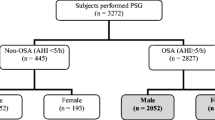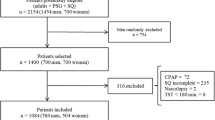Summary
Objective
To compare the age-dependent severity and clinical profile of men and women with polysomnographically-documented obstructive sleep apnea syndrome (OSAS).
Method
A retrospective comparison of polysomnographic and clinical data obtained from 358 carefully age- and RDI-matched men and women with OSAS diagnosed in the Technion Sleep Laboratories.
Results
We found that women complained significantly more on “difficulties falling asleep”, “early morning awakenings”, “morning fatigue”, “mid-sleep awakenings” and “morning headaches”. Nevertheless, stepwise regression analysis revealed that subjective complaints were significant predictors of RDI in men only.
Conclusions
We conclude that the clinical profile of OSAS in women is different from that in men, and that these differences should be taken into account when evaluating women suspected of having OSAS.
Zusammenfassung
Fragestellung
Ein Vergleich von altersabhängigem Schweregrad und klinischem Bild des polysomnographisch dokumentierten Schlaf-Apnoe-Syndroms bei Männern und Frauen.
Methode
Ein nach Alter und RDI an 358 Männern und Frauen mit OSAS vorgenommener retrospektiver Vergleich polysomnographischer und klinischer Daten, die in den Schlaflaboratorien des Technions auf gezeichnet wurden.
Ergebnisse
Frauen beklagen signifikant häufiger “Schwierigkeiten, einzuschlafen” und “morgendliche Kopfschmerzen”. Nichtsdestotrotz ergaben schrittweise Regressionsanalysen, dass subjektive Klagen nur bei Männern signifikante Prädiktoren für einen RDI waren.
Schlussfolgerungen
Es ist zu schließen, dass das klinische Bild des OSAS bei Frauen anders ist als das bei Männern, und dass diese Unterschiede bei der Beurteilung berücksichtigt werden müssen, wenn bei Frauen der Verdacht auf ein OSAS besteht.
Similar content being viewed by others
References
Ambrogetti A, Olson LG, Saunders NA. Differences in symptoms of men and women with obstructive sleep apnea. Aust WZ J Med 21:863–866, 1991.
Balestrieri M, Bortolomasi M, Galletta M, Bellantuono C. Patterns of hypnotic drug prescription in Italy. A two week community survey. Br J Psychiatry 170:176–180, 1997.
Bliwise DL, Nekich JC, Dement WC Relative validity of self-reported snoring as a symptom of sleep apnea in a sleep clinic population. Chest 99:600–608, 1991.
Block JA, Boysen PG, Wynne J, Hunt LA. Sleep apnea, hypopnea and oxygen desaturation in normal subjects: a strong male predominance. N Eng J Med 130:513–517, 1979.
Chervin RD. Sleepiness, fatigue, tiredness, and lack of energy in obstructive sleep apnea. Chest 118:372–379, 2000.
Guilleminault C, Quera-Salva MA, Partinen M, Jamieson A. Women and the obstructive sleep apnea syndrome. Chest 93: 104–109, 1988.
Lavie P. Incidence of sleep apnea in a presumably healthy working population: A significant relationship with excessive daytime sleepiness. Sleep 1983, 6:312–18.
O'Connor C, Thornley KS, Hanly PJ. Gender differences in the polysomnographic features of obstructive sleep apnea. Am J Respir Crit Care Med 161:1465–1472, 2000.
Ohayon M. Epidemiological study on insomnia in the general population. Sleep 9:S7-S15, 1996.
Redline S, Kimp K, Tishler PV, et al. Gender differences in sleep disordered breathing in a community-based sample. Am J Respir Crit Care Med 149:722–726, 1994.
Ware JC, McBrayer RH, Scott JA. Influence of sex and age on duration and frequency of sleep apnea events. Sleep 23: 165–170, 2000.
Young T, Palta M, Dempsey J, et al. The occurrence of sleep-disordered breathing among middle-aged adults. New Engl J Med 328: 1230–1235, 1993.
Young T, Hutton R, Finn L, et al. The gender bias in sleep apnea diagnosis: Are women missed because they have different symptoms. Arch Intern Med 156:2445–2451, 1996.
Author information
Authors and Affiliations
Corresponding author
Rights and permissions
About this article
Cite this article
Lavie, P., Pillar, G. Gender and age differences in symptoms' profile in sleep apnea syndrome: A possible cause of gender bias in diagnosis. Somnologie 5, 93–96 (2001). https://doi.org/10.1046/j.1439-054X.2001.01162.x
Issue Date:
DOI: https://doi.org/10.1046/j.1439-054X.2001.01162.x




